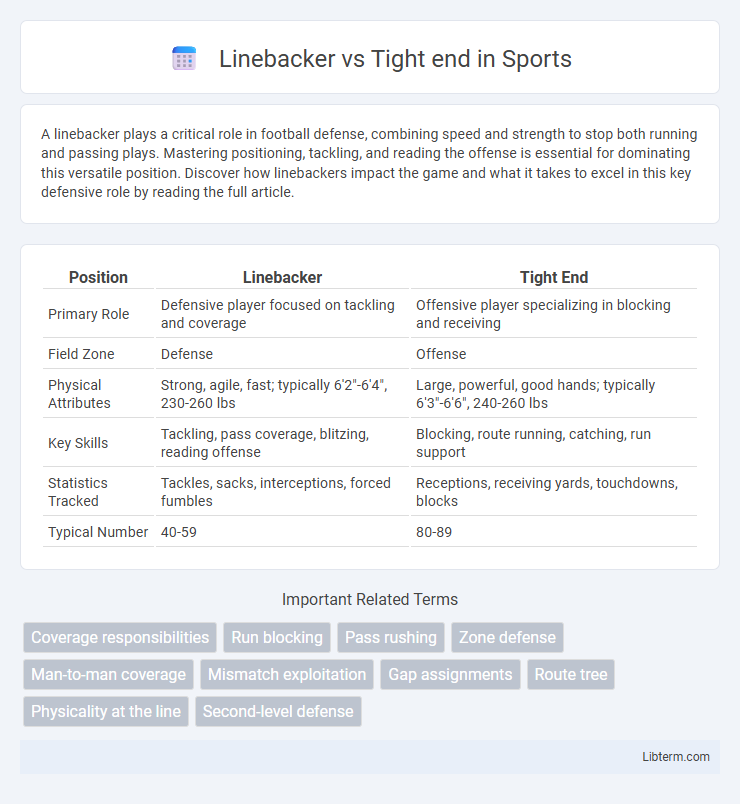A linebacker plays a critical role in football defense, combining speed and strength to stop both running and passing plays. Mastering positioning, tackling, and reading the offense is essential for dominating this versatile position. Discover how linebackers impact the game and what it takes to excel in this key defensive role by reading the full article.
Table of Comparison
| Position | Linebacker | Tight End |
|---|---|---|
| Primary Role | Defensive player focused on tackling and coverage | Offensive player specializing in blocking and receiving |
| Field Zone | Defense | Offense |
| Physical Attributes | Strong, agile, fast; typically 6'2"-6'4", 230-260 lbs | Large, powerful, good hands; typically 6'3"-6'6", 240-260 lbs |
| Key Skills | Tackling, pass coverage, blitzing, reading offense | Blocking, route running, catching, run support |
| Statistics Tracked | Tackles, sacks, interceptions, forced fumbles | Receptions, receiving yards, touchdowns, blocks |
| Typical Number | 40-59 | 80-89 |
Introduction to Linebackers and Tight Ends
Linebackers are defensive players positioned behind the defensive line, responsible for stopping the run, covering receivers, and pressuring the quarterback, making them versatile defensive assets. Tight ends are offensive players who serve as both blockers and receivers, lining up next to the offensive line to support running plays and catch short to intermediate passes. Both positions require a combination of size, speed, and agility but specialize in distinct roles on the football field.
Key Roles and Responsibilities
Linebackers primarily focus on defense by tackling ball carriers, covering receivers, and blitzing the quarterback to disrupt offensive plays. Tight ends serve as dual-role players, combining blocking responsibilities to protect the quarterback or open running lanes with receiving duties to catch passes and advance the ball. Both positions require agility and strength but differ as linebackers concentrate on defensive strategy while tight ends contribute to offensive versatility.
Physical Attributes and Skills Required
Linebackers require exceptional physical strength, speed, and agility to effectively tackle opponents and cover both running backs and receivers, along with advanced skills in reading offensive plays and executing tackles. Tight ends need a combination of size, strength, and agility to block defensive players and run precise routes for catching passes, exhibiting skills in route running, catching, and blocking techniques. Both positions demand high football IQ, but linebackers emphasize defensive awareness while tight ends focus on versatile offensive roles.
Positioning and Field Placement
Linebackers position themselves in the defensive backfield, typically 3 to 5 yards behind the line of scrimmage, adapting their alignment based on offensive formations and play calls. Tight ends line up on the offensive line's edge, either next to the tackles or slightly off the line, balancing between blocking and receiving roles. Field placement for linebackers emphasizes coverage and run-stopping zones, while tight ends focus on exploiting soft spots in zone defenses or creating mismatches in man coverage.
Defensive vs. Offensive Functions
Linebackers primarily focus on defensive functions such as reading offensive plays, stopping the run, and covering short-to-intermediate pass routes, often serving as the defense's key tacklers and pass defenders. Tight ends serve offensive roles by blocking for the run game and acting as versatile receivers who can create mismatches against linebackers or defensive backs. The linebacker's agility and coverage skills counter the tight end's combination of size and speed, making their matchup critical in both run defense and passing situations.
Training and Drills for Each Position
Linebackers focus on training that sharpens agility, tackling technique, and coverage skills through drills like sled pushes, shuttle runs, and shadowing receivers to enhance reaction time and lateral movement. Tight ends prioritize a blend of strength, route-running, and catching drills, including cone drills for footwork, weighted ball catches for hand strength, and blocking sled exercises to build blocking power. Both positions require position-specific conditioning to optimize performance in their respective offensive or defensive roles.
Famous Linebackers and Tight Ends
Famous linebackers such as Ray Lewis and Derrick Thomas are renowned for their defensive prowess, speed, and tackling ability, making significant impacts on their teams' defensive strategies. On the offensive side, legendary tight ends like Tony Gonzalez and Rob Gronkowski are celebrated for their exceptional receiving skills, blocking capabilities, and versatility, often serving as crucial playmakers in the passing game. Both positions require distinct skill sets that have evolved, with linebackers excelling in defense and tight ends bridging the gap between linemen and wide receivers.
Evolution of the Positions in Modern Football
Linebackers have evolved from primarily run-stoppers to versatile defenders excelling in pass coverage and blitzing, adapting to faster, more complex offenses. Tight ends have transformed from traditional blockers to dynamic offensive weapons, emphasizing route running, speed, and receiving skills to create matchup advantages. The modern game demands linebackers with hybrid skills and tight ends who can exploit defensive schemes, reflecting the strategic evolution of football offenses and defenses.
Matchup Dynamics: Linebackers vs. Tight Ends
Linebackers vs. tight ends involve critical matchup dynamics where linebackers must balance coverage and run-stopping responsibilities. Tight ends exploit mismatches by using size and agility to challenge linebackers in both pass routes and blocking schemes. Success in these matchups often hinges on the linebacker's ability to read plays quickly and maintain positioning against versatile tight ends.
Choosing the Right Position: Which Fits You Best?
Linebackers excel in defensive roles, requiring speed, strength, and tactical awareness to read offenses and tackle opponents effectively. Tight ends combine blocking prowess with receiving skills, demanding agility, route-running ability, and reliable hands for both offensive protection and pass catching. Choosing the right position depends on your physical attributes and skill set: if you thrive in defense and tackling, linebacker suits you; if you prefer versatile offensive responsibilities, tight end is a better fit.
Linebacker Infographic

 libterm.com
libterm.com